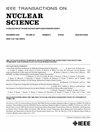Improving the Radiation Resistance of the Fiber via Bismuth Depositing
IF 1.9
3区 工程技术
Q3 ENGINEERING, ELECTRICAL & ELECTRONIC
引用次数: 0
Abstract
Erbium-doped fiber (EDF), bismuth-erbium co-doped fiber (BEDF) without bismuth deposited bismuth on the fiber surface (BEDF1), and BEDF with bismuth deposited on the fiber surface (BEDF2) were fabricated. Leveraging the Geant4 toolkit, the theoretical models of BEDFs are established. When the thickness of the bismuth deposited layer is通过沉积铋提高光纤的抗辐射性能
制备了掺铒光纤(EDF)、未在光纤表面沉积铋的铋-铒共掺光纤(BEDF) (BEDF1)和表面沉积铋的掺铒光纤(BEDF2)。利用Geant4工具包,建立了bedf的理论模型。当铋层厚度为$5~\mu $ m时,沉积在堆芯中的能量降低了49.66% (5.91 MeV)。当Bi3+离子浓度为10 wt%时,堆芯沉积的能量降低了19.7% (1.06 MeV)。EDF、BEDF1和BEDF2分别用0.3、0.5、0.8和1.5 kgy剂量的Co60源照射。经1.5 kGy辐射后,BEDF2在1300 nm处的辐射诱导吸收(RIA)比BEDF1低20.31% (1.01 dB/m)。EDF的辐射诱导增益变化(RIGV)和荧光寿命随辐照剂量的增加而减小,而BEDF1和BEDF2的辐射诱导增益变化和荧光寿命均呈先增大后减小的线性关系。经过0.5 kgy的辐射后,BEDF2的归一化增益增加了1.08 dB/m。光纤芯内的铋离子提高了光纤的抗辐射性能,沉积在光纤表面的铋离子进一步提高了抗辐射性能。研究结果在辐射环境探测和空间卫星定位方面具有参考价值和应用潜力。
本文章由计算机程序翻译,如有差异,请以英文原文为准。
求助全文
约1分钟内获得全文
求助全文
来源期刊

IEEE Transactions on Nuclear Science
工程技术-工程:电子与电气
CiteScore
3.70
自引率
27.80%
发文量
314
审稿时长
6.2 months
期刊介绍:
The IEEE Transactions on Nuclear Science is a publication of the IEEE Nuclear and Plasma Sciences Society. It is viewed as the primary source of technical information in many of the areas it covers. As judged by JCR impact factor, TNS consistently ranks in the top five journals in the category of Nuclear Science & Technology. It has one of the higher immediacy indices, indicating that the information it publishes is viewed as timely, and has a relatively long citation half-life, indicating that the published information also is viewed as valuable for a number of years.
The IEEE Transactions on Nuclear Science is published bimonthly. Its scope includes all aspects of the theory and application of nuclear science and engineering. It focuses on instrumentation for the detection and measurement of ionizing radiation; particle accelerators and their controls; nuclear medicine and its application; effects of radiation on materials, components, and systems; reactor instrumentation and controls; and measurement of radiation in space.
 求助内容:
求助内容: 应助结果提醒方式:
应助结果提醒方式:


